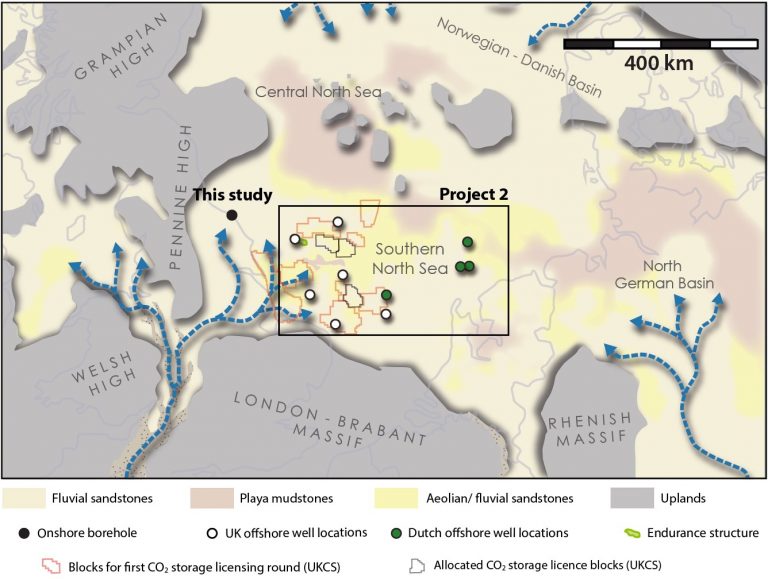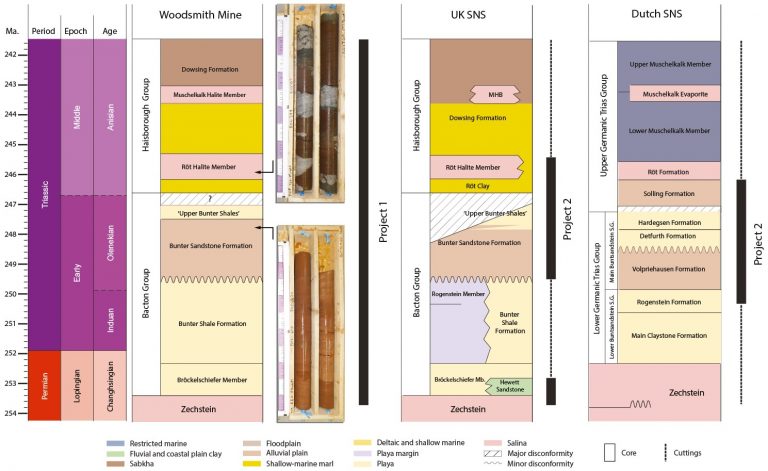A palynozonation of the Bunter Sandstone CO2 storage complex: onshore analogue study (CASP.BSSC.1)
The chronostratigraphy and internal subdivision of the Bunter Sandstone CO2 storage complex are poorly constrained. Early to Middle Triassic ephemeral fluvial to aeolian-sabkha strata provide an opportunity to address these knowledge gaps through a high-resolution palynological study. This will ultimately aid the modelling of stratal architecture and CO2 migration pathways in the subsurface, which are essential for ensuring safe, long-term CO2 storage.
Research programme
This project will establish a palynological reference section for the Lower to Middle Triassic Bunter Sandstone CO2 storage complex through a high-resolution study of newly available borehole cores from the Woodsmith Mine, North Yorkshire (Figs 1, 2). The cores provide a continuous record of regional Triassic sedimentation and display close lithological similarity to the offshore succession, making them highly relevant to carbon storage projects in the Southern North Sea. The high-resolution palynozonation established in this project will be applied in subsequent work (CASP.BSSC.2 & 3) to provide age control and establish a reservoir-scale correlation framework for key wells in the UK and Dutch sectors. This study is one of several complementary projects comprising CASP’s Bunter Sandstone Storage Complex research theme that seek to understand the cyclostratigraphic, climatic and sedimentological controls on reservoir and seal quality and architecture.


Deliverables
Results will be delivered via an interim data release with an associated presentation for client companies and a final technical report containing sedimentary logs for the Woodsmith Mine cores, a high-resolution zonal scheme and bioevent stratigraphy for the Bunter Sandstone Formation and adjacent units (based on the analysis of up to 250 samples), a palynomorph range and occurrence chart in StrataBugs format, and photographic plates of index taxa. The project will conclude with a client workshop during which all data and interpretations will be presented and discussed.
Project duration
The project will launch at the beginning of September 2022 and has a planned duration of 20 months.
Contact: Niall Paterson for further information about this research and licensing options.
Products
- Thematic Research
- Mudrock Seals in CO2 Storage Systems Thematic Research
- Bunter Sandstone Storage Complex Thematic Research
- A palynozonation of the Bunter Sandstone CO2 storage complex: onshore analogue study (CASP.BSSC.1)
- Palynostratigraphy of the Bunter Sandstone CO2 storage complex in the Southern North Sea (CASP.BSSC.2)
- Cyclostratigraphy of the Early to Middle Triassic of the Southern North Sea (CASP.BSSC.3)
- Reservoir composition and diagenesis (CASP.BSSC.4)
- Controls on Bunter Sandstone composition (CASP.BSSC.5)
- Middle Triassic seals – onshore analogue study (CASP.BSSC.6)
- Middle Triassic seals – UK and Dutch offshore wells study (CASP.BSSC.7)
- Reactions and Flow of CO2 Fluid in Compositionally Immature Sandstones Thematic Research
- The Impact of Volcaniclastic Rocks on CO2 Storage Thematic Research
- Non-thematic Research
- Reports
- Data Packages
- Geological Collections and Data
